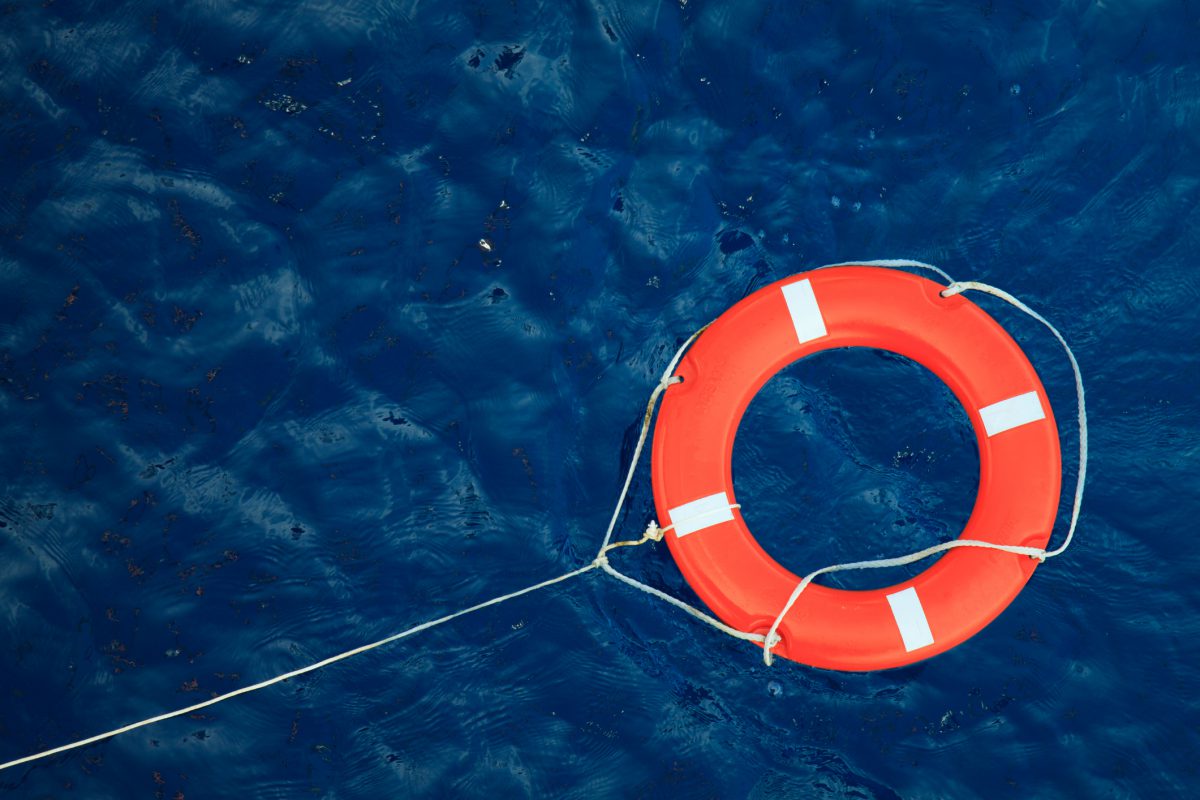Swimbladders — how they work, what can go wrong (and a list of some of the fish that don’t have them)
When we jump into a swimming pool or the sea, it soon becomes apparent that we are not built for this watery setting. Even if we fill our lungs with air we still have to expend a lot of energy by treading water to prevent sinking. The reason we are not buoyant is that our bodies are denser than the surrounding water.
Interestingly fishes have the same problem. The specific gravity (SG) of pure water at 4°C is 1, and seawater has an SG around 1.029 depending on temperature. When it comes to fish, their skeletons have a SG of 2.0, scales and other tissues in the fish have an SG of 1.05-1.1, and fats and oils have an SG around 0.9. The combination of these various densities equates to a SG of the whole fish of around 1.06-1.09 making them denser than their freshwater or seawater medium. Yet when we observe fishes in our aquaria or ponds it is instantly apparent that, when healthy, they are neutrally buoyant: they neither sink nor float to the surface.
Neutral buoyancy can be achieved in a number of ways. For example, cartilaginous fishes exploit the lighter density of oils while pelagic sharks such as the blue shark, (Prionace glauca), concentrate the oil squalene (SG = 0.8562), in their liver. Up to 80% of the liver mass may be squalene and the liver can comprise 25% of the body weight of the shark. Squids perform a similar trick using ammonium chloride rather than oil.
Concentrating a low SG compound in the body to impart neutral buoyancy requires a considerable amount of the compound and a significant anatomical adaptation to house it. However, these compounds are incompressible, meaning neutral buoyancy is not affected by the depth of water so the animal is free to move great distances vertically in the water column – a privilege denied to many bony fishes – as we shall see.
Just as we must expend energy to tread water to remain buoyant so, in a way, so many fishes. Pectoral fins can be used to ‘hover’, tunas, for example, have fins modified into hydrofoils, so providing they are swimming above a minimal velocity (0.6 m/s for Katsuwonus pelamis – the skipjack tuna), then sufficient lift is generated to counteract their SG greater than seawater.
We know that treading water is hard work; it is also energetically very expensive for the fish, which is why many bony fishes that live in the upper 200 M of the water column usually have a gas bladder. This organ has several other names; air bladder, for instance, is an inappropriate term as though the bladder can contain oxygen, carbon dioxide and nitrogen, each is in significantly different proportions than found in the air. Swimbladder is another commonly used term, though pedantically this implies the organ has a solely locomotory function. This is certainly not the case and many fishes use their gas bladders in sound reception and production. The marine gulf toadfish (Opsanus tau) contracts sonic muscles against its gas bladder to generate a sound so loud that collectively it can be a great nuisance to coastal residents. These sonic muscles can contract at a frequency up to 200 Hz at 25°C, making them the fastest muscles in the animal kingdom, (a mouse’s leg muscles can contract no faster than around 25 Hz at 35 °C).
Gas bladders lie beneath the spine in the body cavity and are outgrowths of the fish’s foregut. In the evolutionary past of the fish, it is believed the gas bladder functioned as a primitive lung. However the energetic benefits of the neutral buoyancy it conferred outweighed its benefits as a respiratory organ. Yet some fishes still retain a respiratory function in their gas bladder – most notably lungfishes. There is no one single type of gas bladder seen in bony fishes, giving us a lovely example of evolution ‘tinkering’. Salmonids have a simple, thin-walled, sausage-shaped gas bladder, that of a cyprinid fishes is doubly-compartmented, and the gas bladder of the Notopterid knife fishes is divided into lateral halves. Interestingly, we humans have found a use for dried fish gas bladders; isinglass is used as a beer clarifier!
The wall of the more advanced gas bladders is not gas-permeable; deposition of a silvery coloured guanine layer substantially reduces gas permeability. Migratory fishes such as salmon that start their lives in fast-flowing streams have smaller gas bladders with less guanine deposition in the gas bladder wall. The neutral buoyancy would be a disadvantage in fast flowing water; however, as the fish moves out to sea the gas bladder enlarges and the guanine deposition thickens. In some fishes the gas bladder remains connected by a narrow tube (the pneumatic duct) to the oesophagus, these fishes are known as the physostomous fish (Greek. physa meaning bladder and stoma meaning mouth). Physoclistous (Greek. kleistos – closed) fishes have lost any connection to the gut; this is considered the more advanced condition of gas bladder. In either case, the gas content of the bladder must be regulated, especially with large vertical movements in the water column. For the physostomes, gas content regulation appears straightforward but for the physoclists, gases must be deposited and up taken via the bloodstream at two separate sites in the gas bladder.
The rete mirable is found in both physostomous and physoclistous gas bladders, it is a dense network of tiny blood vessels that has to perform the challenging task of excreting oxygen from the lower oxygen pressure (around 0.2 atmosphere – atm), in the blood to a higher partial pressure in the gas bladder which may be hundreds of atmospheres. This is achieved by the rete concentrating lactic acid, which lowers the pH of the blood specifically at the region where the rete vessels contact the gas bladder wall. The locally low pH encourages the red blood cells to deposit their oxygen. A downshift of one pH unit will lead to the release of half of the oxygen by haemoglobin of the red blood cells. As the blood departs the gas bladder in the rete, the pH must be raised back to normal.
Therefore the rete is responsible for the secretion of gas into the gas bladder. The physostomes can then expel excess gas via the pneumatic duct. Herrings, (Clupea harengus), have an additional vent in the gas bladder, a pore behind the anus, which they use to expel gas from the gas bladder making a characteristic chirping sound. The physoclists have no such venting so again must rely on the blood stream to remove excess gas from the gas bladder. At the rear upper end of the gas bladder lies the ‘oval’ a gas secretory portion of the bladder wall that the fish can close off with a sphincter muscle. When some gas needs to be removed from the bladder the sphincter relaxes and gas diffuses from a high pressure in the gas bladder to a lower pressure in the blood vessels that perfuse the oval.
So why is the regulation of gas content so important to the fish? Surely once there is a sufficient quantity of gas to counteract the water displacement caused by the weight of the fish the job is done? For fishes with gas bladders a huge problem arises when the fish moves down in the water column. For every 10 M of depth there is an increase in hydrostatic pressure of 1 atm. If a fish drops 10 M from the surface the total gas pressure doubles from 1 to 2 atm, so the gas bladder volume halves. As fish rises to the surface the reverse situation occurs. A physoclistous fish will restrict its vertical range and move between depths slowly however, when fishes are rapidly bought to the surface eversion of the gas bladder out of the mouth or anus is commonly seen.
A recent study on lessening the damage this causes to wild-caught reef fishes demonstrated that wild caught yellow tangs (Zebrasoma flavescens), showed reduced mortality and stress when given a slower ascent to the surface in addition to decompression stops compared to those fish that were brought straight to the top. Reef fishers often ‘vent’ their catches, whereby the gas bladder is punctured with a needle to rapidly remove excess gas. The same study showed that, counterintuitively, this treatment did not seem to damage the gas bladder tissue.
In the aquarium some fish can often exhibit buoyancy problems. The most notable examples are the forms of fancy goldfish that have a compressed spine. The curvature of the spine seems to place undue pressure on the gas bladder, which complicates the fish’s ability to regulate the gas content. As physostomes, goldfish should be able to expel excess gas via the pneumatic duct but this often appears challenging. For some specimens it is feeding at the surface, often on extruded pellet diets that leads to air passing down the oesophagous and into the gas bladder. Tetra has been contacted by many fancy goldfish keepers, who report their pets will float at the surface following feeding. Switching to a rapidly sinking diet such as Tetra Goldfish Gold Japan or a wet diet such as Tetra FreshDelica can prevent air ingestion. A traditional treatment of pre-soaking the fish food prior to feeding is not a good idea as water-soluble vitamins will be lost from the food leading to potentially deleterious vitamin deficiencies in the fish.
Buoyancy problems can occasionally be caused by pathogenic infections; in ornamental fishes haemorrhage of the membrane of the gas bladder is sometimes seen at autopsy, however this is often accompanied by haemorrhage and additional signs of infection on other organs of the viscera indicating a systemic bacterial infection. A fish with such a bacterial infection will appear extremely poorly with buoyancy problems being part of a larger suite of issues. A broad-spectrum aquarium antiseptic may be of use, however relying on water-borne treatments to treat internal infections can be overoptimistic.
There are even some parasites that colonise the gas bladder; the native European eel (Anguilla anguilla) is highly susceptible to the nematode worm parasite Anguilicola crassus. This worm is believed to have entered the UK from imports of the Japanese eel (A. japonica), and once inside, will colonises the gas bladder. Very heavy infections can cause rupture of the organ, but even moderate infections lead to a thickening and loss of elasticity of the gas bladder wall. This makes it difficult for the eel to regulate the gas pressure inside the gas bladder, complicating their ability to maintain a neutral buoyancy. This proves especially disasterous when the adults begin their long migration across the Atlantic Ocean back to the Sargasso Sea to spawn. A. crassus is one of numerous threats to the once plentiful eel in this country.
Overall the gas bladder makes an interesting talking point as it is a highly variable and complex organ found in many bony fishes. Its principal function is provision of neutral buoyancy though some fishes also use it in sound detection, production and air breathing.

